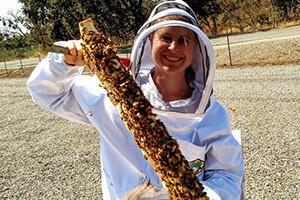
AAPA Scholarship Award Recipient
I am Patricia Bohls, the recent recipient of the AAPA Scholarship Award. I have attached for you a picture, a brief biography, and a summary of my proposal for your publication.
Patricia Bohls
Bohls, PA. – PROTEOMIC AND COMPARATIVE GENOMIC ANALYSIS OF SEMINAL FLUID IN APIS MELLIFERA DRONES FROM REGIONS WITH OR WITHOUT VARROA DESTRUCTOR AND CONSEQUENCES ON QUEEN REPRODUCTIVE HEALTH
University of California, Davis,
Briggs Hall RM 37 -CA 95616
Email:pabohls@ucdavis.edu
Studies on insect reproduction cross a wide variety of fields and multiple studies have been conducted with other insects, particularly fruit flies. These studies have shown that seminal fluid components can cause a wide variety of behavioral and physiological effects in females including reduced longevity (South and Lewis, 2011. Biol Rev. 86: 299-309). Previous studies also show that parasites can have an effect on the seminal fluid of their hosts which in turn can have a negative effect on offspring development, as with bacteria Wolbachia in parasitoid Spalangia cameroni (Kyei-Poku et.al., 2006. Entomol. Exp. Appl. 121: 123-135). Honey bee queens, due to development of instrumental insemination, present an excellent system for understanding the various factors regulating post-mating changes. More specifically understanding how selection pressures from parasites (such as Varroa destructor) have shaped reproductive processes has the potential to help answer what might be some of the issues modulating honey bee queen health.
Varroa is an ectoparasitic mite on Apis mellifera; it feeds on hemolymph and vectors several pathogens (Rosenkranz et. al., 2010. J Invertebr Pathol. 103: 96-119). Varroa tends to prefer parasitizing drones and are rarely found on queens. Since the introduction of Varroa, and its spread throughout the U.S., bee-associated viruses have become a more substantial problem (Yue and Genersch, 2005 J. Gen. Virol. 86: 3419–3424). Current research shows that Varroa has a negative effect on drone weight, sperm viability, and their mating flight successes (Dennis et al., 2003. Genome Biol. 5: 3, Huang, Sherman, and Lempicki, 2009. Nat Protoc, 1: 44-57). Despite their importance, no work as of yet, has compared the effects of selection pressures of Varroa mites on seminal fluid components in drones and the effect that might have on queen post-mating changes. My Ph.D. project will examine drones from areas where Varroa has been introduced at different times or is still absent: the continental United States (1980s), Hawaii (2007 and some islands are still without it), and Australia (still absent).
My research questions are: 1) What are the differences between seminal fluid proteins of drones from areas with or without Varroa? 2) How does drone seminal fluid with or without Varroa affect queen reproductive health and longevity? 3) What are the long-term consequences for the colony?
I will collect drone semen samples from Hawaii and Australia to be used for proteomic analysis. To minimize the effects of genetic background, I will only obtain drones from a single subspecies. SDS-PAGE technique will be used to show the protein profiles of seminal fluid from continental U.S., Hawaiian, and Australian drones. Proteins will be identified using gel spots cut from the 2-D IEF/SDS-PAGE. I will then artificially inseminate super-sister queens with the semen of drones from each geographic region. To avoid accidental introduction of Varroa into regions without it, the queen work will be …
Patricia Bohls is a first-year Entomology Ph.D. candidate at the University of California, Davis. She is working under the guidance of Dr. Elina Niño. In May 2015 she graduated from Hiram College with a double major in Neuroscience and Environmental Studies and a minor in Biology. While at Hiram she was the captain of the Cross Country team and the General Manager of the Stone Soup Vegetarian Cooperative. In the past she was awarded a National Science Foundation Research Experience for Undergraduates internship and has a publication accepted by the Ohio Biological Survey. At UC Davis she is researching the evolution of seminal fluid proteins in honey bees based upon their exposure to Varroa mites and is also highly involved in extension work.


